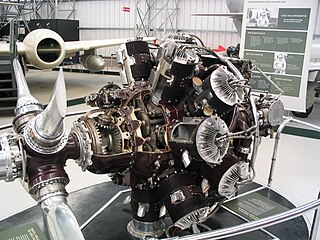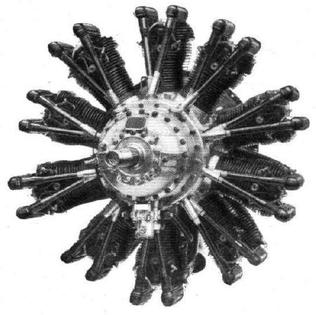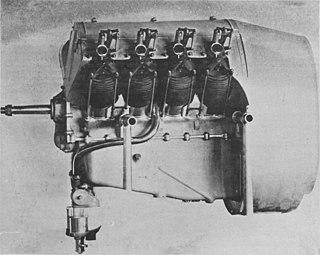
The Bristol Pegasus is a British nine-cylinder, single-row, air-cooled radial aero engine. Designed by Roy Fedden of the Bristol Aeroplane Company, it was used to power both civil and military aircraft of the 1930s and 1940s. Developed from the earlier Mercury and Jupiter engines, later variants could produce 1,000 horsepower (750 kW) from its capacity of 1,750 cubic inches by use of a geared supercharger.

The Bristol Perseus was a British nine-cylinder, single-row, air-cooled radial aircraft engine produced by the Bristol Engine Company starting in 1932. It was the first production sleeve valve aero engine.

The Bristol Hercules is a 14-cylinder two-row radial aircraft engine designed by Sir Roy Fedden and produced by the Bristol Engine Company starting in 1939. It was the most numerous of their single sleeve valve designs, powering many aircraft in the mid-World War II timeframe.

The Siddeley Puma was a British aero engine developed towards the end of World War I and produced by Siddeley-Deasy. The first engines left the production lines of Siddeley-Deasy in Coventry in August 1917, production continued until December 1918. At least 4,288 of the 11,500 ordered engines were delivered, orders were cancelled following the Armistice. Production was continued under the name Armstrong Siddeley Puma when the manufacturer was bought by Armstrong Whitworth and became Armstrong Siddeley.

The Rolls-Royce Eagle Mk XXII is a British 24-cylinder, sleeve valve, H-block aero engine of 46 litre displacement. It was designed and built in the early-1940s by Rolls-Royce Limited and first ran in 1944. It was liquid-cooled, of flat H configuration with two crankshafts and was capable of 3,200 horsepower at 18 psi boost.

The Armstrong Siddeley Cheetah is a seven-cylinder British air-cooled aircraft radial engine of 834 cu in capacity introduced in 1935 and produced until 1948. Early variants of the Cheetah were initially known as the Lynx Major.

The Armstrong Siddeley Leopard was a British 14-cylinder twin-row air-cooled radial aero engine developed in 1927 by Armstrong Siddeley. It was the most powerful radial engine in the world when introduced.

The Armstrong Siddeley Jaguar was an aircraft engine developed by Armstrong Siddeley. The Jaguar was a petrol-fuelled air-cooled 14-cylinder two-row radial engine design. The Jaguar III was first used in 1923, followed in 1925 by the Jaguar IV and in 1927 by the Jaguar VI. In 1925 the Jaguar became the first production aero engine incorporating a geared supercharger.

The Armstrong Siddeley Panther was a 27-litre 14-cylinder twin-row air-cooled radial aero engine developed by Armstrong Siddeley. It was originally named the Jaguar Major.

The Armstrong Siddeley Lynx is a British seven-cylinder aero engine developed by Armstrong Siddeley. Testing began in 1920 and 6,000 had been produced by 1939. In Italy Alfa Romeo built a 200 horsepower (150 kW) licensed version of this engine named the Alfa Romeo Lynx.

The Armstrong Siddeley Mongoose is a British five-cylinder radial aero engine produced by Armstrong Siddeley. Developed in the mid-1920s it was used in the Hawker Tomtit trainer and Parnall Peto seaplane amongst others. With a displacement of 540 cubic inches (9 litres) the Mongoose had a maximum power output of 155 horsepower (115 kilowatts).

The Armstrong Siddeley Serval was a British ten-cylinder aero engine developed by Armstrong Siddeley in the late 1920s. Following company tradition, the engine was named for the serval.

The Siddeley Tiger was an unsuccessful British aero engine developed shortly after the end of World War I by Siddeley-Deasy. Problems encountered during flight testing caused the project to be cancelled.
The Armstrong Siddeley Hyena was a British aero engine developed by Armstrong Siddeley. Designed in the 1930s, it was an unusual experimental radial engine with inline cylinder banks. It was flown using an Armstrong Whitworth A.W.16 fighter aircraft as a test bed. Unresolved problems with cooling of the rear cylinders prevented the engine from going into production. Few details of this engine survive as company records were lost.

The Armstrong Siddeley Cougar was an aero engine developed by Armstrong Siddeley in 1945. The design was a departure from earlier Armstrong Siddeley engines in many ways, it was the company's only nine-cylinder radial design. Although the engine was tested it did not find an aircraft application and was not produced.

The Armstrong Siddeley Deerhound was a large aero engine developed by Armstrong Siddeley between 1935 and 1941. An increased capacity variant known as the Boarhound was never flown, and a related, much larger, design known as the Wolfhound existed on paper only. Development of these engines was interrupted in April 1941, when the company's factory was bombed, and on 3 October 1941 the project was cancelled by the Air Ministry.

The Armstrong Siddeley Ounce was a small two-cylinder aero engine developed by Armstrong Siddeley in 1920. The engine was originally conceived as a test piece but ran very well and was put into production for early ultralight aircraft and use in target drones. The Ounce used two cylinders from the preceding Jaguar I radial engine.

The Renault 70 hp or Type WB was a French V-8 aero engine that first ran circa 1907. It was also manufactured under license by Renault Limited of West Brompton, London between August 1914 and December 1918, three other companies, including Rolls-Royce, also produced the engine. A variant known as the Type WC used an external oil pump as opposed to the internal pump of the Type WB. The Renault V-8 engines were noted as inefficient but reliable, the inefficiency being mainly due to the excessively rich fuel/air mixture used to assist cooling.

The RAF 4 was a British air-cooled, V12 engine developed for aircraft use during World War I. Based on the eight–cylinder RAF 1 it was designed by the Royal Aircraft Factory but produced by the two British companies of Daimler and Siddeley-Deasy. The RAF 5 was a pusher version of the same engine.

The Beardmore 120 hp was a British six-cylinder, water-cooled aero engine that first ran in 1914, it was built by William Beardmore and Company as a licensed-built version of the Austro-Daimler 6. The engine featured cast iron cylinders and mild steel concave pistons. Produced between August 1914 and December 1918, the design powered many World War I aircraft types.


















